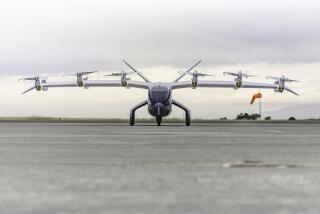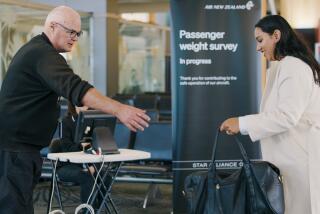Testing greener ways to fly
AUCKLAND, NEW ZEALAND — A major initiative to help cut airline flight times, burn less fuel and reduce harmful carbon emissions is to be presented today by the Federal Aviation Administration at San Francisco International Airport.
Amid the roar of jet engines, acting FAA Administrator Robert Sturgell will speak upon the arrival of an Air New Zealand flight from Auckland that will use a host of new technologies and procedures designed to save time and fuel.
FAA and airline officials hope the normally 12-hour, 6,500-mile flight will be shorter in duration and cut fuel use by hundreds of pounds compared with similar flights. It would mark the first of several tests that -- if successful -- could change the way airlines fly locally, nationally and overseas.
“This is going to be a big one for business,” Sturgell said Thursday. “As a former airline pilot myself, I can tell you this will change how things work from gate to gate.”
With oil prices still hovering at more than $100 a barrel, the FAA initiative is likely to attract significant attention from airlines, particularly from U.S. carriers looking at billions of dollars in losses this year because of high fuel expenses.
For passengers, the initiative could mean less waiting on the tarmac before takeoff and after landing, shorter flights and perhaps fewer flight delays, FAA officials said.
But Joe Brancatelli, editor of business travel website Joesentme.com, questioned whether the initiative would help curtail airlines’ practice of packing flights into certain hours of the day, which he believes is a major factor in flight delays and wasted airline fuel.
“It’s like stuffing 6 pounds of sugar in a 5-pound bag and then complaining when the bag breaks,” he said. Spreading flights throughout the day is “not sexy like the FAA initiative, but it’s solving this boring practical stuff that will save more fuel.”
The Air New Zealand flight, a regularly scheduled service with hundreds of passengers, is being conducted in partnership with FAA and New Zealand aviation officials.
The FAA is working with Air New Zealand because the airline has been at the forefront of finding new ways of making flights more environmentally friendly and fuel efficient.
Aside from some frequent fliers, most passengers are unlikely to notice much of a difference.
The plane’s approach into San Francisco is also expected to be smoother and quieter because the plane will descend gradually in a straight line, as though it was on cruise control, compared with how most planes have to throttle the jet engines up and down to follow the typical step-down landing pattern.
The FAA hopes to implement the so-called tailored approach at Los Angeles International Airport next year.
Sturgell said today’s flight was likely to be for the most part “transparent to the passengers, but the pilots, the air-traffic controllers and the industry are going to sit up and take notice.”
The initiative with Air New Zealand began as a way to reduce carbon emissions, which scientists believe contribute to global warming and weather changes. But it evolved into a more complicated and expanded move to save fuel and time, airline and New Zealand aviation officials said.
For the FAA, the flight will incorporate many of the procedures that it has been developing under a plan to modernize the nation’s air transportation system, using satellite and other new technologies to make flying more efficient.
The procedures include working with air-traffic controllers so that a plane can get from the gate to the runway as quickly and smoothly as possible. And during the flight, the pilot and air-traffic controllers in New Zealand and in the U.S. are expected to collaborate regularly on setting the most direct, fuel-efficient route, taking up-to-date wind and weather conditions into consideration. Flights currently follow a specific route planned prior to takeoff, often based on weather reports that might be outdated by the time the plane leaves the gate.
FAA officials said a separate initiative was underway with Europe and an airline there, with plans to conduct a similar flight over the Atlantic.
If all goes well with the Air New Zealand flight today, Sturgell said, “it saves time, gas and money.”
--
--
Pae reported from Auckland before departing for San Francisco on the Air New Zealand flight.
More to Read
Inside the business of entertainment
The Wide Shot brings you news, analysis and insights on everything from streaming wars to production — and what it all means for the future.
You may occasionally receive promotional content from the Los Angeles Times.










